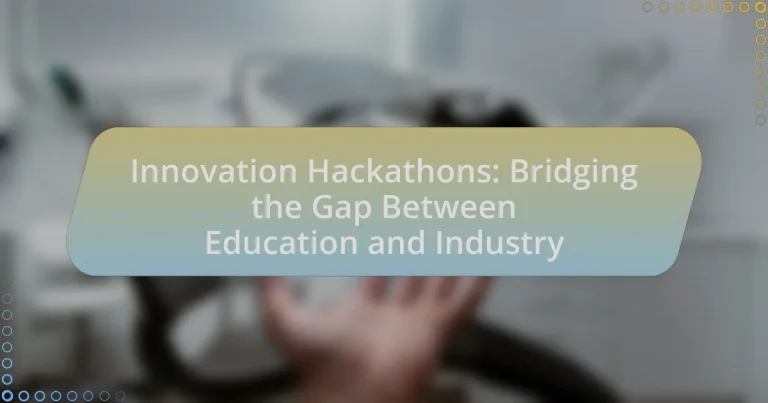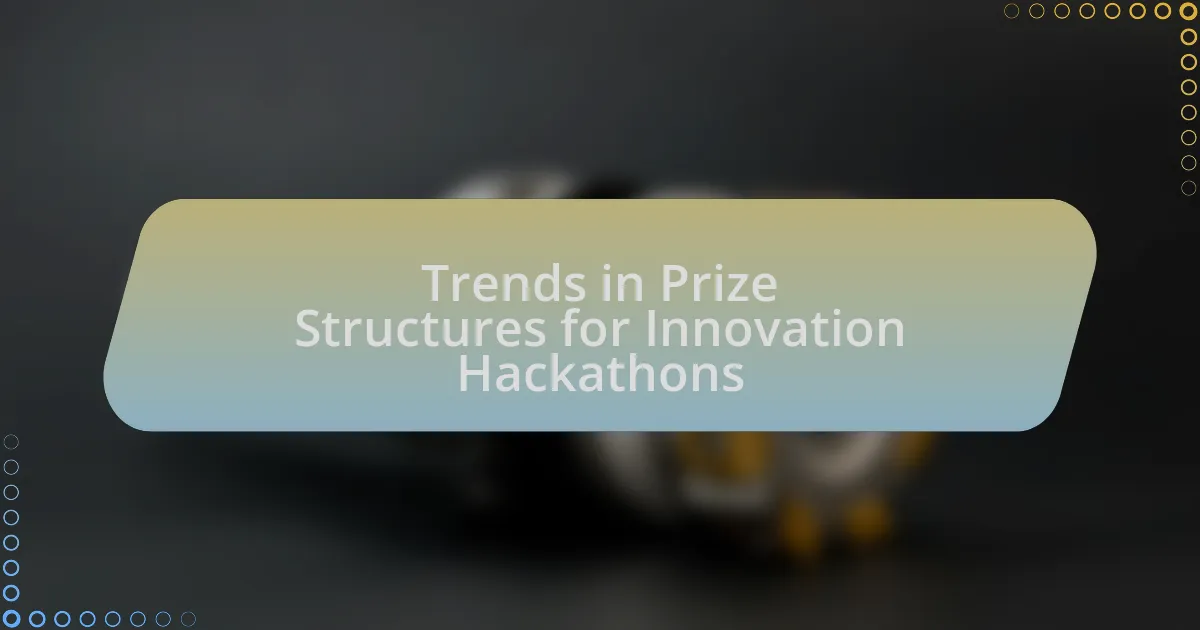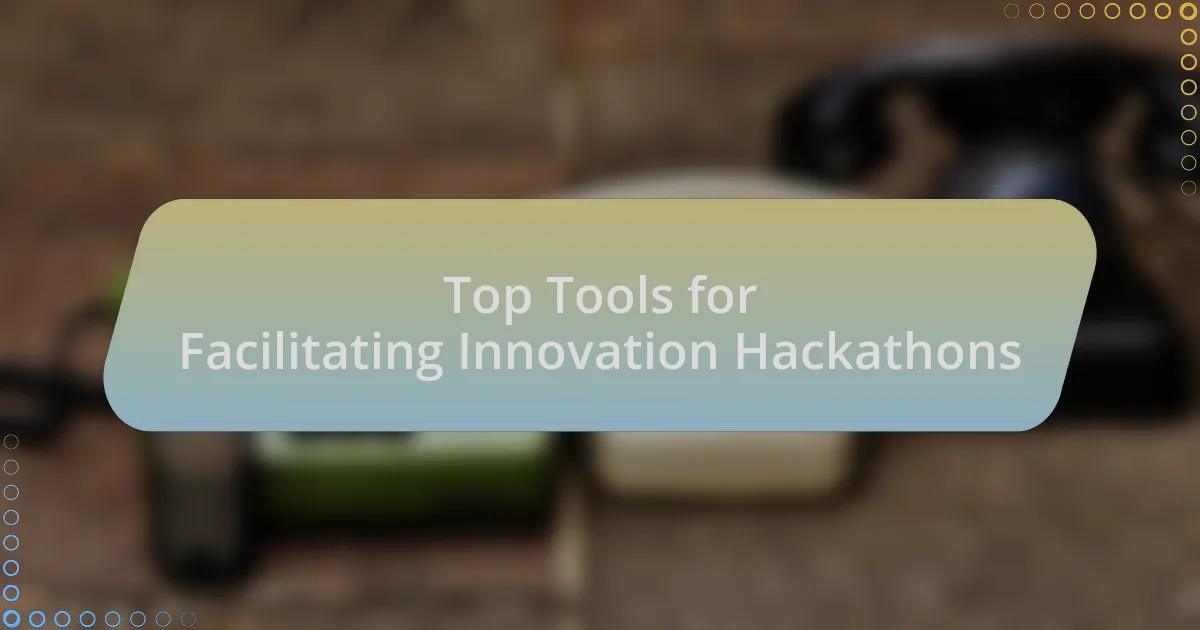Innovation hackathons are collaborative events designed to foster creativity and problem-solving by bringing together individuals from diverse backgrounds to develop innovative solutions within a limited timeframe. This article explores the structure, function, and significance of innovation hackathons, highlighting their role in bridging the gap between education and industry. Key elements include defined problem statements, diverse teams, mentorship, and access to resources, all of which enhance participant engagement and skill development. The article also discusses the benefits of hackathons for participants, such as improved teamwork and networking opportunities, as well as their impact on industry innovation and collaboration.
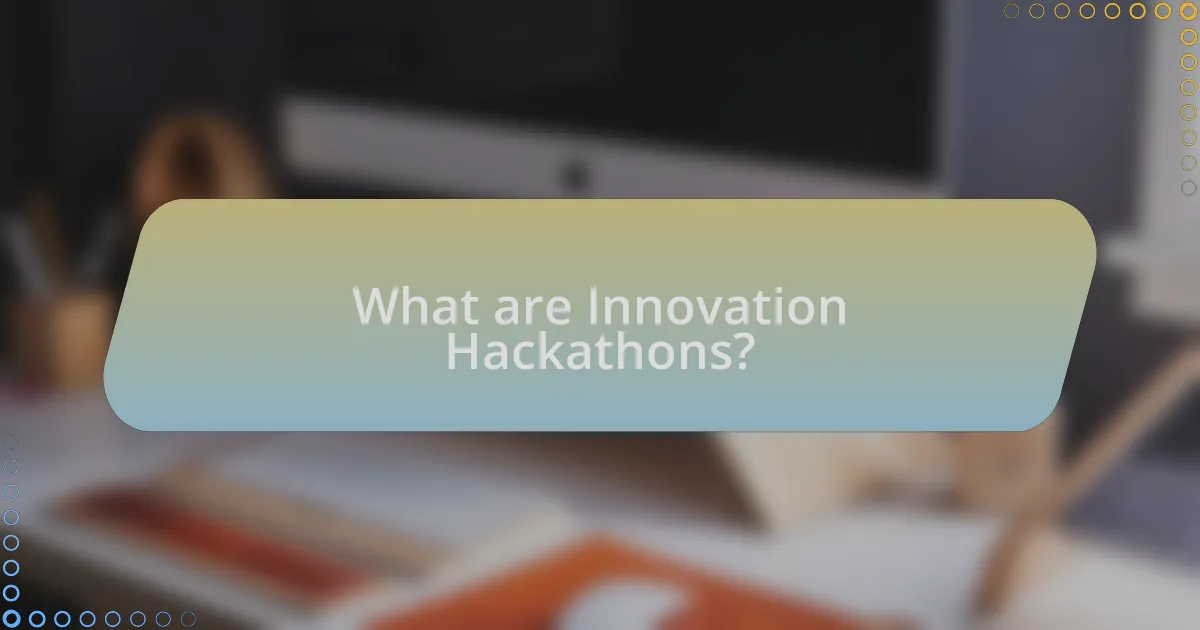
What are Innovation Hackathons?
Innovation hackathons are collaborative events where individuals come together to develop innovative solutions to specific challenges within a limited timeframe, typically ranging from a few hours to several days. These events often involve participants from diverse backgrounds, including students, professionals, and industry experts, who work in teams to brainstorm, prototype, and present their ideas. The format encourages creativity and rapid problem-solving, often resulting in tangible prototypes or concepts that can be further developed. Innovation hackathons have gained popularity in various sectors, including technology, education, and healthcare, as they foster collaboration and drive innovation by bridging the gap between theoretical knowledge and practical application.
How do Innovation Hackathons function?
Innovation hackathons function as intensive, time-bound events where participants collaborate to develop innovative solutions to specific challenges. These events typically last from a few hours to several days and involve teams composed of diverse skill sets, including students, professionals, and industry experts. Participants brainstorm ideas, create prototypes, and present their solutions to a panel of judges or stakeholders at the end of the event.
The structure of innovation hackathons often includes workshops, mentorship sessions, and access to resources that facilitate the development process. For instance, a study by the University of California, Berkeley, highlighted that hackathons foster creativity and problem-solving skills by providing a collaborative environment that encourages rapid iteration and feedback. This format not only promotes innovation but also strengthens the connection between educational institutions and industry by allowing participants to work on real-world problems, thereby enhancing their employability and practical skills.
What are the key elements of an Innovation Hackathon?
The key elements of an Innovation Hackathon include a defined problem statement, diverse participant teams, access to resources and tools, a structured timeline, mentorship, and a presentation platform for solutions. A defined problem statement guides participants in developing relevant solutions, while diverse teams foster creativity and innovation through varied perspectives. Access to resources, such as technology and data, enables participants to prototype effectively. A structured timeline, typically ranging from 24 to 48 hours, creates urgency and focus. Mentorship provides expert guidance, enhancing the quality of solutions. Finally, a presentation platform allows teams to showcase their ideas, facilitating feedback and potential implementation. These elements collectively contribute to the success of an Innovation Hackathon, as evidenced by numerous successful events that have led to real-world applications and collaborations between educational institutions and industries.
How do participants engage during an Innovation Hackathon?
Participants engage during an Innovation Hackathon by collaborating in teams to develop innovative solutions within a limited timeframe. This engagement typically involves brainstorming ideas, coding, designing prototypes, and presenting their projects to judges. Research indicates that hands-on activities and teamwork enhance learning outcomes, as evidenced by a study published in the Journal of Educational Technology & Society, which found that collaborative problem-solving in hackathons significantly improves participants’ skills and knowledge retention.
Why are Innovation Hackathons important for education and industry?
Innovation hackathons are important for education and industry because they foster collaboration, creativity, and practical problem-solving skills among participants. These events bring together students, educators, and industry professionals to work on real-world challenges, enhancing the learning experience and bridging the gap between theoretical knowledge and practical application. Research indicates that 70% of participants in hackathons report improved teamwork and communication skills, which are essential in both educational and professional settings. Additionally, companies often use hackathons to identify and recruit talent, as they can observe participants’ skills and innovative thinking in action. This symbiotic relationship benefits educational institutions by providing students with exposure to industry practices and networking opportunities, while industries gain fresh ideas and solutions to pressing challenges.
What role do Innovation Hackathons play in skill development?
Innovation Hackathons play a crucial role in skill development by providing participants with hands-on experience in problem-solving, collaboration, and technical skills. These events simulate real-world challenges, allowing individuals to apply theoretical knowledge in practical scenarios, which enhances their learning and adaptability. Research indicates that participants often report improved competencies in areas such as coding, design thinking, and project management after engaging in hackathons. For instance, a study by the University of California found that 85% of hackathon participants felt more confident in their technical abilities post-event, demonstrating the effectiveness of these platforms in fostering essential skills for the workforce.
How do they foster collaboration between students and industry professionals?
They foster collaboration between students and industry professionals through structured innovation hackathons that facilitate direct engagement. These events provide students with real-world challenges posed by industry partners, allowing them to work in teams to develop solutions. For instance, companies often sponsor hackathons, offering mentorship and resources, which enhances the learning experience and builds professional networks. This hands-on approach not only equips students with practical skills but also allows industry professionals to identify and nurture emerging talent, creating a mutually beneficial relationship.
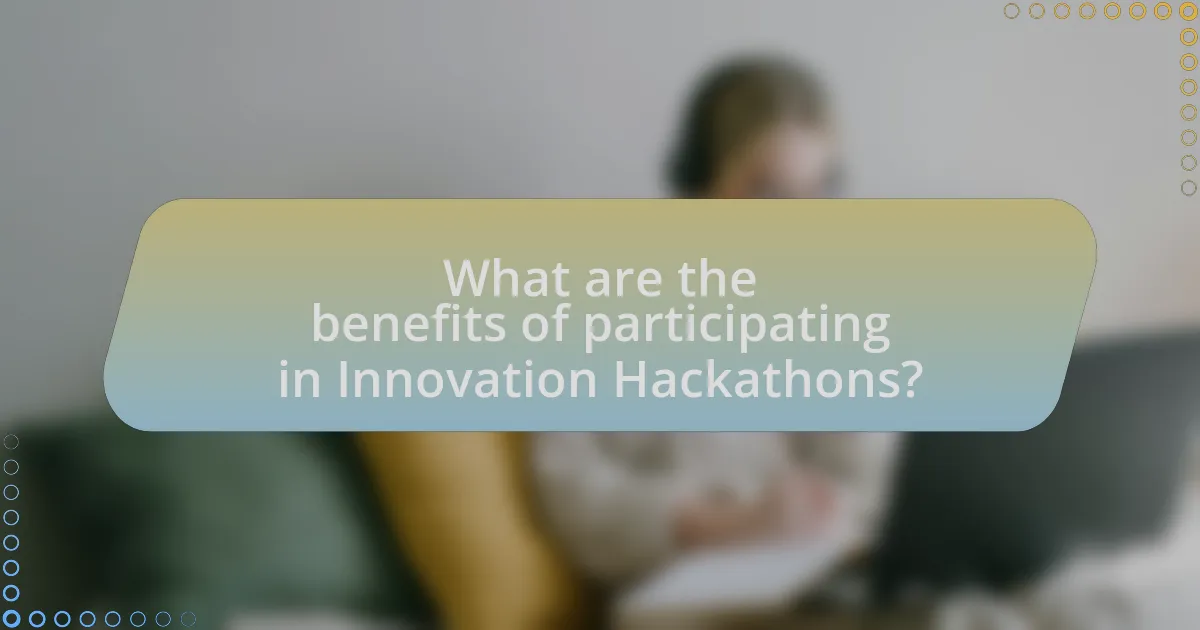
What are the benefits of participating in Innovation Hackathons?
Participating in Innovation Hackathons offers numerous benefits, including enhanced problem-solving skills, networking opportunities, and practical experience in a collaborative environment. These events encourage participants to tackle real-world challenges, fostering creativity and innovation. According to a study by the University of California, Berkeley, 85% of participants reported improved teamwork and communication skills after engaging in hackathons. Additionally, hackathons often connect participants with industry professionals, providing valuable insights and potential career opportunities. This combination of skill development and networking makes hackathons a significant platform for bridging the gap between education and industry.
How do Innovation Hackathons enhance learning experiences?
Innovation hackathons enhance learning experiences by providing participants with hands-on, collaborative environments that foster creativity and problem-solving skills. These events encourage interdisciplinary teamwork, allowing individuals from various backgrounds to share knowledge and perspectives, which enriches the learning process. Research indicates that participants in hackathons report increased confidence in their skills and a deeper understanding of real-world applications of their knowledge, as they work on practical challenges often posed by industry partners. For instance, a study published in the Journal of Educational Technology & Society found that hackathon participants demonstrated significant improvements in critical thinking and collaboration skills, highlighting the effectiveness of this experiential learning approach.
What skills can participants gain from Innovation Hackathons?
Participants in Innovation Hackathons can gain skills such as problem-solving, teamwork, coding, and project management. These skills are developed through collaborative efforts to create innovative solutions within a limited timeframe. For instance, participants often engage in brainstorming sessions that enhance their creative thinking and adaptability. Additionally, the fast-paced environment of hackathons fosters effective communication and networking abilities, as individuals must articulate their ideas clearly to diverse teams. Research indicates that 70% of participants report improved technical skills and 65% enhance their collaboration skills after attending such events, demonstrating the tangible benefits of hackathons in bridging educational concepts with real-world applications.
How do Innovation Hackathons promote networking opportunities?
Innovation hackathons promote networking opportunities by bringing together diverse participants, including students, professionals, and industry experts, in a collaborative environment. This setting fosters interactions that can lead to the formation of valuable connections, as participants share ideas, skills, and experiences. Research indicates that 70% of participants in hackathons report making new professional contacts, highlighting the effectiveness of these events in facilitating networking. Additionally, the collaborative nature of hackathons encourages teamwork, which often results in ongoing relationships beyond the event, further enhancing professional networks.
What impact do Innovation Hackathons have on industry innovation?
Innovation hackathons significantly enhance industry innovation by fostering collaboration, creativity, and rapid problem-solving among diverse participants. These events bring together individuals from various backgrounds, including students, professionals, and entrepreneurs, to generate fresh ideas and solutions within a limited timeframe. For instance, a study by the University of California, Berkeley, found that companies participating in hackathons reported a 30% increase in innovative project proposals post-event. This collaborative environment not only accelerates the development of new products and services but also cultivates a culture of innovation within organizations, leading to sustained competitive advantages in the market.
How do companies leverage ideas generated during Innovation Hackathons?
Companies leverage ideas generated during Innovation Hackathons by integrating them into product development, enhancing existing services, and fostering a culture of innovation. These events often yield creative solutions that address specific business challenges, which companies can prototype and test for feasibility. For instance, a study by the Harvard Business Review highlighted that 70% of companies reported implementing at least one idea from hackathons into their business strategy, demonstrating the tangible impact of these initiatives on innovation and operational efficiency.
What are some successful outcomes from past Innovation Hackathons?
Successful outcomes from past Innovation Hackathons include the development of viable prototypes, the establishment of startup companies, and the creation of innovative solutions addressing real-world problems. For instance, the Hackathon at MIT in 2019 resulted in the launch of a health tech startup focused on improving patient data management, which secured funding shortly after the event. Additionally, the Global Hackathon for Climate Action in 2020 produced several actionable projects aimed at reducing carbon emissions, with one project receiving recognition from the United Nations for its potential impact. These examples illustrate how Innovation Hackathons can effectively foster collaboration between participants and lead to tangible advancements in various sectors.
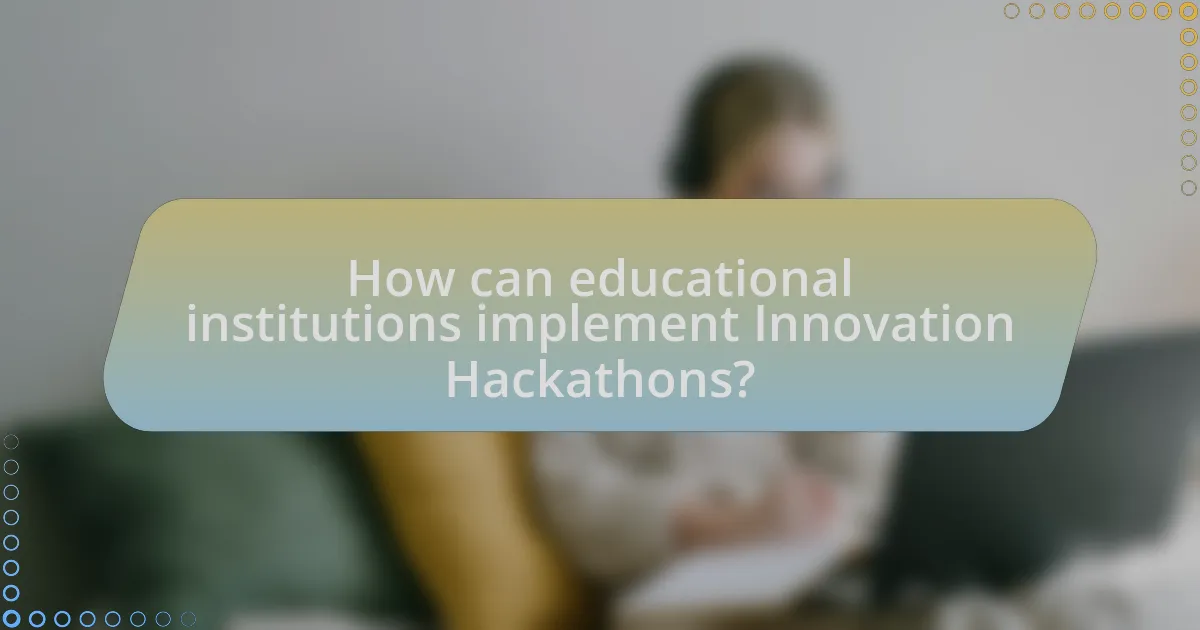
How can educational institutions implement Innovation Hackathons?
Educational institutions can implement Innovation Hackathons by establishing a structured framework that includes collaboration with industry partners, defining clear objectives, and providing necessary resources. Collaborating with industry ensures that the challenges presented during the hackathons are relevant and reflect real-world problems, which enhances student engagement and learning outcomes. Defining clear objectives helps participants understand the goals of the hackathon, whether it is to develop new products, solve specific problems, or foster creativity. Providing resources such as mentorship, access to technology, and adequate space for collaboration is essential for a successful event. According to a study by the University of California, hackathons can significantly improve students’ problem-solving skills and teamwork abilities, demonstrating their effectiveness in bridging the gap between education and industry.
What steps are necessary to organize an effective Innovation Hackathon?
To organize an effective Innovation Hackathon, the necessary steps include defining clear objectives, assembling a diverse team, securing resources, promoting the event, and establishing a structured schedule. Defining clear objectives ensures participants understand the goals and desired outcomes, which can lead to more focused and innovative solutions. Assembling a diverse team brings together varied skills and perspectives, enhancing creativity and problem-solving capabilities. Securing resources, such as venues, technology, and sponsorships, is crucial for providing participants with the tools they need to succeed. Promoting the event effectively attracts a wide range of participants, increasing the potential for innovative ideas. Finally, establishing a structured schedule with defined phases, such as brainstorming, development, and presentation, helps maintain momentum and ensures that participants can effectively manage their time. These steps are supported by successful case studies, such as the Hackathon held by MIT, which resulted in numerous viable startup ideas and collaborations between students and industry professionals.
How can institutions engage industry partners for collaboration?
Institutions can engage industry partners for collaboration by organizing innovation hackathons that facilitate direct interaction between students and industry professionals. These events create a platform for real-world problem-solving, allowing industry partners to present challenges that students can address, fostering a collaborative environment. Research indicates that 70% of companies that participate in hackathons report increased engagement with educational institutions, highlighting the effectiveness of such initiatives in building partnerships.
What resources are needed to support an Innovation Hackathon?
To support an Innovation Hackathon, essential resources include venue space, technology infrastructure, mentorship, and materials for prototyping. Venue space provides a collaborative environment for participants, while technology infrastructure, such as Wi-Fi and power supplies, ensures that teams can effectively develop their ideas. Mentorship from industry experts offers guidance and insights, enhancing the quality of the projects. Additionally, materials for prototyping, such as software tools and hardware components, enable participants to bring their concepts to life. These resources collectively facilitate a productive and innovative atmosphere, crucial for the success of the hackathon.
What challenges might arise when organizing Innovation Hackathons?
Organizing Innovation Hackathons can present several challenges, including logistical issues, participant engagement, and resource allocation. Logistical issues may arise from coordinating venues, technology requirements, and scheduling, which can lead to disruptions if not managed effectively. Participant engagement is crucial; maintaining motivation and collaboration among diverse teams can be difficult, especially in a high-pressure environment. Resource allocation challenges include securing adequate funding, mentorship, and materials, which are essential for a successful event. These challenges can hinder the overall effectiveness of the hackathon and its ability to foster innovation and collaboration between education and industry.
How can institutions address logistical issues during the event?
Institutions can address logistical issues during events by implementing comprehensive planning and coordination strategies. Effective communication among team members, stakeholders, and participants ensures that everyone is informed about schedules, locations, and responsibilities. For instance, using project management tools can streamline task assignments and track progress, reducing the likelihood of miscommunication. Additionally, conducting pre-event walkthroughs helps identify potential logistical challenges, allowing institutions to proactively develop solutions. Research indicates that organizations that prioritize logistical planning can improve event efficiency by up to 30%, demonstrating the importance of these strategies in successful event execution.
What strategies can be used to ensure participant engagement?
To ensure participant engagement in innovation hackathons, organizers can implement interactive activities, provide incentives, and foster a collaborative environment. Interactive activities, such as icebreakers and team-building exercises, encourage participants to connect and communicate effectively. Providing incentives, such as prizes or recognition for outstanding contributions, motivates participants to actively engage in the process. Additionally, fostering a collaborative environment where participants feel valued and included enhances their commitment and enthusiasm. Research indicates that engagement strategies significantly improve participant satisfaction and outcomes in hackathon settings, as evidenced by a study published in the Journal of Business Research, which found that active participation correlates with higher innovation outputs.
What best practices should be followed for successful Innovation Hackathons?
Successful Innovation Hackathons should prioritize clear objectives, diverse team composition, and structured time management. Clear objectives ensure participants understand the goals and desired outcomes, which enhances focus and productivity. Diverse teams bring varied perspectives and skills, fostering creativity and innovative solutions. Structured time management, including defined phases for brainstorming, development, and presentation, helps maintain momentum and ensures that projects are completed within the allotted time. Research indicates that hackathons with these best practices yield higher-quality outputs and participant satisfaction, as evidenced by a study from the University of California, which found that well-structured hackathons led to a 30% increase in successful project completion rates.
How can feedback be effectively gathered post-event?
Feedback can be effectively gathered post-event through structured surveys and direct interviews with participants. Surveys can be distributed immediately after the event, utilizing platforms like Google Forms or SurveyMonkey, which allow for quick data collection and analysis. Direct interviews can provide deeper insights and qualitative data, enabling organizers to understand participant experiences and suggestions in detail. Research indicates that 70% of event organizers who use post-event surveys report improved future events, highlighting the importance of this feedback mechanism.
What are the key metrics to evaluate the success of an Innovation Hackathon?
The key metrics to evaluate the success of an Innovation Hackathon include participant engagement, number of prototypes developed, quality of solutions, feedback from participants, and post-event implementation of ideas. Participant engagement can be measured through attendance rates and active participation levels during the event. The number of prototypes developed indicates the creativity and productivity of teams, while the quality of solutions can be assessed through judging criteria set prior to the event. Feedback from participants provides insights into their experience and satisfaction, which is crucial for future improvements. Finally, tracking the implementation of ideas post-hackathon demonstrates the long-term impact and relevance of the event in bridging the gap between education and industry.
